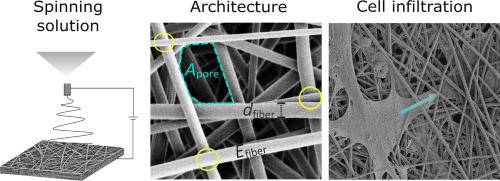Biomaterials Advances ( IF 7.9 ) Pub Date : 2021-09-15 , DOI: 10.1016/j.msec.2021.112427 Alexandre Morel 1 , Anne Géraldine Guex 2 , Fabian Itel 3 , Sebastian Domaschke 4 , Alexander E Ehret 4 , Stephen J Ferguson 5 , Giuseppino Fortunato 3 , René M Rossi 3

|
Controlling the architecture of engineered scaffolds is of outmost importance to induce a targeted cell response and ultimately achieve successful tissue regeneration upon implantation. Robust, reliable and reproducible methods to control scaffold properties at different levels are timely and highly important. However, the multiscale architectural properties of electrospun membranes are very complex, in particular the role of fiber-to-fiber interactions on mechanical properties, and their effect on cell response remain largely unexplored. The work reported here reveals that the macroscopic membrane stiffness, observed by stress-strain curves, cannot be predicted solely based on the Young's moduli of the constituting fibers but is rather influenced by interactions on the microscale, namely the number of fiber-to-fiber bonds. To specifically control the formation of these bonds, solvent systems of the electrospinning solution were fine-tuned, affecting the membrane properties at every length-scale investigated. In contrast to dichloromethane that is characterized by a high vapor pressure, the use of trifluoroacetic acid, a solvent with a lower vapor pressure, favors the generation of fiber-to-fiber bonds. This ultimately led to an overall increased Young's modulus and yield stress of the membrane despite a lower stiffness of the constituting fibers. With respect to tissue engineering applications, an experimental setup was developed to investigate the effect of architectural parameters on the ability of cells to infiltrate and migrate within the scaffold. The results reveal that differences in fiber-to-fiber bonds significantly affect the infiltration of normal human dermal fibroblasts into the membranes. Membranes of loose fibers with low numbers of fiber-to-fiber bonds, as obtained from spinning solutions using dichloromethane, promote cellular infiltration and are thus promising candidates for the formation of a 3D tissue.
中文翻译:

定制电纺膜的多尺度结构以促进 3D 细胞浸润
控制工程支架的结构对于诱导靶向细胞反应并最终在植入后成功实现组织再生至关重要。在不同水平控制支架特性的稳健、可靠和可重复的方法是及时且非常重要的。然而,电纺膜的多尺度结构特性非常复杂,特别是纤维间相互作用对机械性能的作用,以及它们对细胞反应的影响在很大程度上仍未得到探索。此处报道的工作表明,通过应力-应变曲线观察到的宏观膜刚度不能仅根据构成纤维的杨氏模量进行预测,而是受微观相互作用的影响,即纤维与纤维的数量债券。为了专门控制这些键的形成,对静电纺丝溶液的溶剂系统进行了微调,影响了所研究的每个长度尺度的膜特性。与以高蒸气压为特征的二氯甲烷相比,使用三氟乙酸(一种蒸气压较低的溶剂)有利于产生纤维与纤维之间的键。尽管构成纤维的刚度较低,但这最终导致膜的杨氏模量和屈服应力总体增加。关于组织工程应用,开发了一种实验装置来研究结构参数对细胞在支架内浸润和迁移能力的影响。结果表明,纤维间键的差异显着影响正常人真皮成纤维细胞向膜中的浸润。从使用二氯甲烷的纺丝溶液中获得的具有少量纤维与纤维键的松散纤维膜促进细胞浸润,因此是形成 3D 组织的有希望的候选者。



























 京公网安备 11010802027423号
京公网安备 11010802027423号